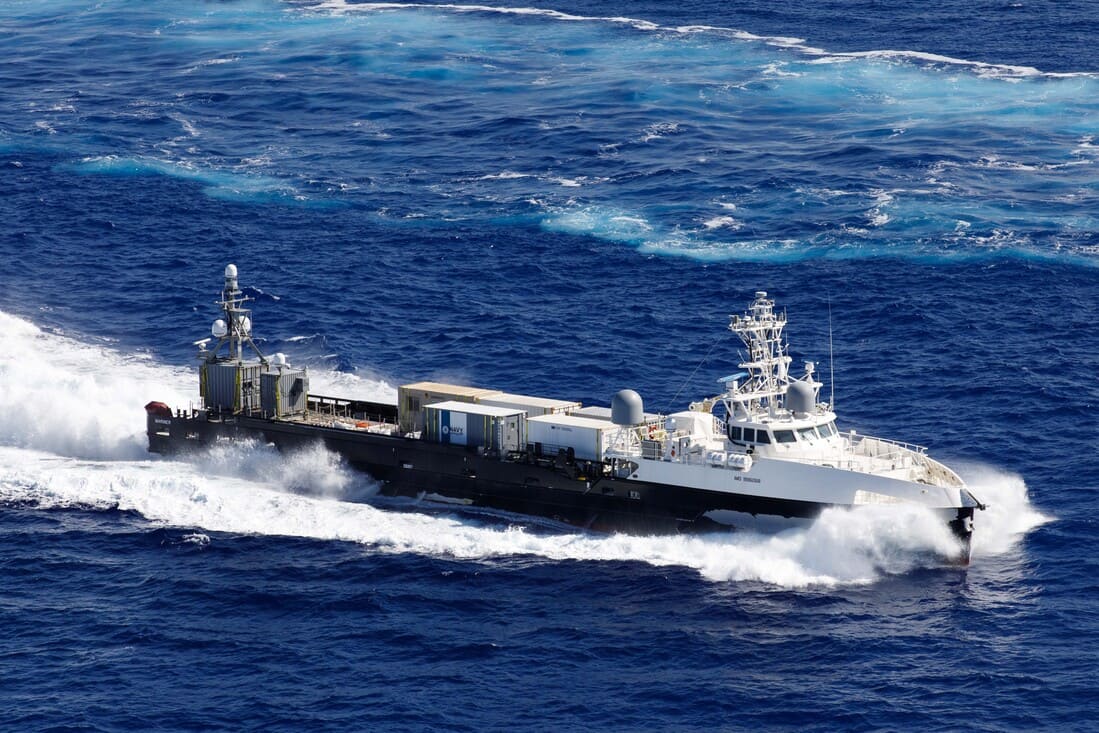The U.S. Navy issued a formal solicitation on July 28, 2025, for a new class of unmanned surface vessels-Modular Attack Surface Craft (MASC)-designed to move from contract award to prototype delivery within 18 months and then scale production across multiple shipyards. White papers are due August 11 at 18:00 Eastern Time. The program will use Other Transaction Authority under 10 U.S.C § 4022 to speed concept development and at-sea demostration.
Rather than prescribe a single hull form, the Navy sets performance requirements for payload, range, speed, seakeeping, autonomy, power budgets and production standards, allowing multiple yards to compete. MASC must employ commercial construction rules, accept modular payloads in ISO containers and be buildable and maintainable across the existing industrial base.
Modular Variant Definitions, Legacy Integration, and Containerized Payload Standards
Three vessel variants fall under the MASC umbrella:
- Baseline: Emphasizes speed and range while carrying two 40-foot containers.
- High-Capacity: Scales up to four 40-foot modules.
- Single-Payload: Centers on a single 20-foot module with a clear stern for towed gear.
Years of work on Ranger, Mariner, Sea Hunter and Seahawk have matured autonomy, command and control, deck handling and payload integration. The new solicitation unifies those advances into a single, scalable approach using ISO container standards instead of custom weapons rooms. As Rear Adm. William Daly put it in January, “What’s in the box – a weapon or a different payload? Keep them guessing.”
According to industry sources, several U.S. yards with fast-ferry and offshore workboat experience can adapt proven platforms to the envelope without waiting for a custom warship design. That point matters for schedule and cost. Commercial standards open a broader supplier pool for hulls, machinery, and repairs, then lean on government oversight where it affects safety, communications, navigation, and weapons interfaces.
The solicitation cites NAICS 336611 (Ship Building and Repairing) and PSC 1905, runs as full and open competition, and specifies electronic submission points of contact.
The payload suite mirrors past demonstrations. The containerized Mk 70 Payload Delivery System fits the baseline deck plan and has already launched an SM-6 from the Ranger. ISR and electronic warfare modules use the same deck interface and power logic. The single-payload variant’s clear transom accomodates towed arrays or other stern-deployed systems.
Autonomy requirements call for COLREGS-compliant collision avoidance, including low-visibility and EMCON conditions, and mission persistance after control-link loss. Sea State 5 performance is “strongly desired”, as is automatic RF-emission posture directed by the control station.
Power remains a core requirement. The baseline variant must support up to 75 kW per 40-foot module, with each deck slot rated for 36.3 metric tons. The high-capacity model scales to four 40-foot modules at 50 kW each. The single-payload version accommodates one 20-foot module-up to 24 metric tons and 75 kW-and demands an unobstructed path to the transom. These parameters drive the sizing of prime movers, auxiliary generators, power distribution networks and thermal-management systems for sustained operations.
Performance, Power, and Autonomy Requirements
Teams must hit an 18-month schedule from award to waterborne prototype. Initial submissions are limited to white papers or slide decks, followed by in-person pitches and final proposals for prototype contracts. The Navy seeks clear technical merit, a credible build plan and stable pricing through yard production.
A tight timeline steers architecture toward proven hull forms. A clean-sheet design requiring new classification approval adds risk against the 18-month clock. By contrast, an existing fast-workboat hull with established stability and deck strength eases sea-trial readiness. The goal is simple: minimize hull variables so payloads determine mission impact, not hull geometry. Officials emphasize that endurance figures must hold under full deck loads, not just appear on paper.
Force Structure, Command Relationships, and Prototype Alignment
MASC also integrates with emerging force structure. Unmanned Surface Vessel Squadron One and Surface Development Group One have been standing up training, maintenance and control networks. In June, the Navy activated Chimera Detachment Charlie at Naval Base Ventura County to build the digital backbone for fleet integration and to support afloat control units.
The fleet concept centers on dispersed effects and flexible loadouts. A baseline craft carries two modules, keeping pace with carrier strike groups or operating independently as a sensor node. The high-capacity variant supports four modules, combining sensing and strike or increasing launcher density without overloading a single deck. The single-module design accommodates drag-sensitive gear and extended acoustic sensors. Commanders can swap mission packages without sending a warship into dry dock.
System Layering and Performance Integration
Designers must balance three layers. Hull form and propulsion dictate endurance and speed. Power generation and distribution determine payload capability. The mission system-autonomy software, datalinks and control stations-defines how many vessels a crew can manage and how safely they navigate crowded seas. The solicitation rewards proposals that demonstrate credible performance across all layers: a hull that feeds a high-demand payload, a power plant sized for peak loads, and autonomy tuned for COLREGS-compliant behavior under emissions control.
Teams face these critical challenges:
- Power and heat management. A 75 kW limit per module rules out many directed-energy weapons unless a vessel carries extra generators or storage-adding both volume and weight.
- Sea-state performance. Sustaining 25 knots in Sea State 4 with mission-weight payloads demands precise weight distribution and center-of-gravity control, not just a fast bare hull.
- Control under EMCON. One shore station managing multiple boats with emissions control needs rock-solid autonomy, reliable contact classification and traffic management to avoid “tunnel vision” in busy waterways.
Payload flexibility remains the program’s sharp edge. Vertical-cell launchers in standard containers can field SM-6 or Tomahawk missiles. ISR modules-passive sensors, active radar, RF mapping and counter-ISR gear-share the same footprint but draw varying power. Top proposals will show reserve generation capacity, cooling headroom and straightforward cable and ventilation routing to avoid choke points.
Command relationships mirror those of small combatant or special-mission units. Unmanned Surface Vessel Squadron One and its detachments have spent 2025 refining autonomy and control stations. That organizational groundwork dovetails with MASC’s goal of fielding prototypes by early 2027.
REFERENCE SOURCES
- https://breakingdefense.com/2025/01/navy-admiral-skeptical-of-large-usvs-future-amid-congressional-scrutiny/
- https://sam.gov/opp/50f14282db7c48a0802563fac9d2921d/view
- https://sam.gov/opp/1befcad1ce8c428dac36b5cddf8a31f5/view
- https://www.navsea.navy.mil/Media/News/Article-View/Article/4261138/us-navy-seeks-industry-feedback-for-modular-attack-surface-craft-program/
- https://www.navsea.navy.mil/Home/PEO-Unmanned-and-Small-Combatants/
- https://breakingdefense.com/2025/07/navy-looks-for-ideas-to-swiftly-prototype-new-usvs/
- https://news.usni.org/2025/07/28/navy-seeks-new-fast-attack-surface-drone-design
- https://www.twz.com/sea/navy-unmasks-its-vision-for-fleet-of-uncrewed-modular-surface-attack-craft
- https://maritime-executive.com/editorials/u-s-navy-wants-to-buy-combat-usvs-for-containerized-payloads
- https://www.congress.gov/crs-product/R45757
- https://www.linkedin.com/posts/jesse-gipe_samgov-activity-7356130563927261185-YtdQ
- https://www.linkedin.com/posts/peo-usc_unmanned-liberatorhunter-unmannedmaritime-activity-7349799715560996864-WTjk



